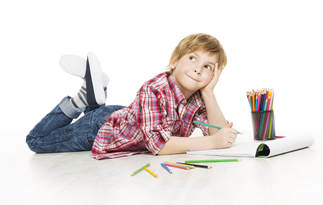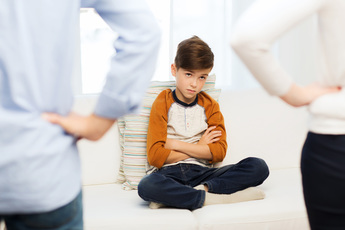 By Emily Kircher-Morris, LPC A child keeps kicking his brother's car seat, even after his mom has asked him to stop. The class clown keeps interrupting the teacher with off-topic and mildly inappropriate comments. A preteen girl crumples her homework and dramatically hides her face in her arms on her desk. A young boy has a meltdown because he is told they are having cookies instead of ice cream for dessert. When trying to figure out what is behind these problematic behaviors, parents and teachers may come to the conclusion the child is engaged in negative attention-seeking. They come to the conclusion that the best response is to ignore or give a negative consequence for the behavior. Many people feel that attention-seeking behavior is a negative trait. The attention the child is seeking is unearned and the result of a child being overly emotional and dramatic. The reaction may be to ignore the behavior or even give a negative consequence to the child. I'd like to suggest a different way to look at attention-seeking behavior. If we consider all behavior to be communication and ask ourselves, "What is the child needing from this interaction?" we may find some ideas of how to handle the behavior. Let's reframe attention-seeking as reassurance-seeking. Their behavior is saying: Am I alone? Do you love me? Am I worthwhile? Even if I act this way, will you stick with me? We all need attention once in a while. We may seek it in positive ways, through accomplishments and helping others. The reassurance we get from those acknowledging us can keep us going. Sometimes kids don't have the language or emotional regulation skills to get their needs met in the most convenient way for us. But, when we remind ourselves the attention-seeking is really reassurance-seeking, we build our relationship with the child and can help them learn more appropriate ways to seek that reassurance from us in the future.
1 Comment
 By Emily Kircher-Morris, LPC Because I work with many high-ability, gifted, and twice-exceptional individuals in my practice, I've noticed an interesting pattern with some of my clients. The story follows a specific path: A bright child was diagnosed with ADHD at a young age. Medication after medication had minimal benefit; often the parents abandoned medication altogether. As the child gets older, their lagging social skills cause more and more problems with friends and at school. We finally determine the appropriate diagnosis of Asperger's Disorder has been missed. Many children compensate well for social struggles and concerns may go unnoticed by parents and educators. If the child is gifted, asynchronous development explains many of the quirks the child may show. However, one would expect that as the bright, quirky, asynchronous child grows older, some skills (such as the ability to meet typical social expectations) would balance out. However, the DSM-V says that for a diagnosis of Autism Spectrum Disorder, symptoms may not fully manifest until social demands exceed the abilities of the individual. When a child's struggles increase with age instead of balancing out, a diagnosis of Autism Spectrum Disorder (ASD)/Asperger's should be considered. So, why are these kids given an ADHD diagnosis instead of ASD? A close look at the symptoms of ADHD through the lens of Asperger's can help understand how this misdiagnosis can be made:
Parents, educators, and medical/mental health professionals need to be aware of the overlap of behaviors between these two diagnoses. If medications don't seem to make a difference for ADHD, it may be beneficial to consider the presence of ASD. If social skills seem to be regressing as a child enters late elementary, middle, or high school instead of balancing out, taking a look for Asperger's could help. And finally, considering each of the behaviors that was originally explained by ADHD, and whether the motivation for the behavior is better explained by traits of ASD, can help find an accurate diagnosis. While any mental health diagnosis for a child can be overwhelming, accurately identifying the cause of problematic behaviors allows for proactive interventions to be implemented earlier and with better efficacy. 
By Emily Kircher-Morris, LPC
'Tis the season to rack your brain for gift ideas for some of those hard-to-buy-for family and friends. One of the hardest among these is your child's teacher. As parents, we don't really always know the teachers personally enough to get them something they really want. So goes the annual search for a gift that is unique (yet general enough that any teacher would like it) and in the right price range (somewhere between $5 Starbucks gift card and a full spa day). I used to be a teacher and a school counselor. Gift cards are always easy and appreciated but sometimes feel impersonal. Snacks are hard because some teachers don't eat gluten or sugar or coffee or chocolate (What????). Knick knacks and ornaments are tough because, eventually, there just isn't enough space to keep them. So - don't spill the beans to my kids' teachers yet - but here is what they are getting for Christmas this year: I'm giving each of them a gift basket filled with fidgets for their classrooms. Research is showing that more and more students learn better when their psychomotor needs are met. Especially for children with ADHD and other sensory needs, a small, unobtrusive fidget actually can help them focus better than without because it stimulates the small portion of the brain that needs a distraction so the other 95% of the brain can focus on the lesson. Adults need this, too; when I provide professional development, I bring baskets of fidgets, Play-Doh, markers, and candy to fill that sensorimotor need. Now, don't worry. I'm not going to stockpile my child's classroom with a full set of fidget spinners. (I know teachers who've had nightmares about out-of-control fidget spinner mutinies in their classrooms!) When I *teach* kids how to use fidgets appropriately (yes, kids need to be taught how to use fidgets to improve their focus), we have a few rules. The fidget cannot distract others, either visually or by making noise, and the person using the fidget needs to be able to maintain eye contact with the person who is speaking or teaching the lesson. Here are some of my favorite fidgets that I'll be giving my kids' teachers this holiday season. I've bought and tried all of these items and have them at my home and office.
These little tangles are a classic fidget that kids love. They twist and coil and wrap. The one downside is that some kids like to pull them apart and put them back together, which can be distracting in the classroom.
This is perfect for those kids who are always tipping their chairs. Simply wrap this exercise style band around the bottom two legs of a classroom chair for kids to use for counter pressure for their legs. Bonus: It won't result in falling over backwards!
Fun little fidget rings roll up and down a thumb or finger with minimal distraction or noise. They provide some pressure - kind of like a little massage for your finger!
File this under "Why Didn't I Think of That?" This little mesh tube that kind of looks like a little Chinese finger trap has a marble trapped inside. Squeeze the marble back and forth to engage kids without distracting others.
Another style of fidget ring, instead of rolling vertically on the finger, it rolls around the finger. The smooth roll this fidget provides is surprisingly calming and satisfying. Again, it is small and won't be distracting to other kids!
Another great option for the child who has a hard time staying still in his or her seat. These wobble seats take just enough effort for kids to stay stabilized so their wiggling isn't a distraction to themselves or others.
(BTW - These are Amazon Affiliate links. If you opt to purchase through this link, a small portion of your purchase price will be donated to the Gifted Support Network 501(c)(3) nonprofit in St. Charles, MO.)
For example, my son refused to wear a bike helmet more than once. Instead of taking his bike away, he had to research and find information about the risks associated with bike helmet safety and regulations. It was time consuming. I had to help him through the process. It also kept him from his preferred activities, but, it was engaging. It allowed him to create new connections in his awareness of the topic. It was much more effective than me lecturing him, too. And when he was able to share his learning, he felt proud of his work instead of ashamed of his mistake.
The downside of restorative consequences it takes effort, time, and creativity on the part of the parent. However, the long-term benefit in learning and the relationship it fosters between you and your child will be worth the effort.  By Emily Kircher-Morris, LPC If I had a dime for every time a child or student told me that they were bored or that something was boring, I'd have enough money for a boring trip to Mexico with my husband. (Wouldn't boring be absolutely wonderful? When did my life go from abhorring boredom to it becoming a life goal? Anyway, I digress...) What I've found through many conversations with children, teens, and parents is that the phrase "I'm bored," or, "This is boring," often doesn't mean what it seems. Here is a handy guide for parents and teachers to understand the possible alternative meanings to complaints of boredom. "I don't have anything to do." Self-regulation is an executive functioning skill and this skill develops based on a child's maturity level. A child may have a million toys, a trillion games, and three-quarters of a ton of arts and crafts supplies. But, thinking about available options, prioritizing which seems the most interesting, and initiating the task are directly related to executive functioning skills and a child may need some ways to help figure out what they want to do. Creating a "menu" of options from which a child can choose or creating a "grab bag" with ideas of activities listed on individual pieces of paper can help take the decision-making out of the choice. "This isn't fun." Helping to clean the house typically isn't exactly a thrill a minute. However, if a child is busy and engaged, they aren't typically "bored." When a child complains of boredom in a school setting because a task isn't fun, parents may misinterpret it as the child saying they aren't challenged. Unfortunately, some academic tasks simply aren't all that fun, no matter what the teacher tries. Perseverance through a task that isn't fun but is necessary isn't easy for adults; helping children focus on the benefits of the outcome and monitoring their progress can help them to build this skill. "This isn't challenging enough." When a child fails to complete schoolwork and complains of being bored in class, it is possible that the work isn't challenging enough. (I should note, though, that many times the complaint is more closely related to one of the two reasons listed above.) This can go in two different directions: In one situation, the child begins acting out and getting in trouble. In the second situation, the child politely sits and completes work, compliant, bored, and not learning. Advocating for your child with the teacher for appropriate work is a necessary step for parents to take if this is the case. "This is too hard." The flip side of not being challenging enough is when a child finds a task too difficult. Sometimes a child doesn't even realize that they don't understand; they just know they don't want to attempt the task. When investigating the root cause of the "I'm bored" refrain, ask the child to restate to the task they are supposed to complete. If they are unable to explain, further instruction, modified requirements, or other accommodations may be appropriate. "I'm lonely." Parenting the child who needs to be with people can be exhausting. Suggestion after suggestion of activity may fall flat if a child is complaining of boredom because they are simply lonely. Recognize the child's need and dedicate time to "fill their bucket" with undivided attention. Negotiate with siblings who may prefer more alone time to engage with the brother or sister who thrives on attention. "I'm generally unhappy and don't know how to fix it." Sometimes kids just aren't happy. They often lack the emotional vocabulary to share how they are really feeling. Perhaps they are feeling worried, defeated, or excluded. "I'm bored" becomes a catchall for these uncomfortable feelings. Digging deeper to see what other emotions are beneath the boredom is key. It is also important to note that children and teens can be susceptible to depression and a child who is frequently uninterested in activities that at one time were engaging can be a warning sign that the child is depressed. "Nothing seems interesting." And finally, when all other options are exhausted, boredom may just be boredeom. Although there are options, none of them seem enticing. My Aunt Francine use to tell us, with unimpressed frankness, "You're not bored; you're boring." The lesson she was hoping to teach is that boredom is easily vanquished with a little creativity and imagination. Teaching kids ways to play with situations in their minds and amuse themselves in boring situations is an excellent skill to learn.  By Emily Kircher-Morris, LPC As parents, we’ve all been there. Your child calls her sister a name, replies to you with a sarcastic tone of voice, or any other typical childish behavior that warrants an apology. “Now say you’re sorry,” we tell them. Embarrassed, or angry, or exasperated, we get an apology: A muttered “Sorry” and a quick exit. Apologies are hard for all of us. How can we help our children grow through the process of making an apology? How can we help them know that a one-word apology doesn’t actually make a difference when it is nothing more than a platitude? How can we help them experience the relief and reprieve of admitting a wrong and the benefit it gives both people involved? Part of the reason that making an apology is so difficult for individuals of all ages is because it requires us to show ultimate vulnerability. We have to admit that what we did was wrong and we recognize the harm it caused. Any apology with less than full acceptance of responsibility of wrong-doing is ineffective. Many of the children and teens I work with in my practice are perfectionists. This makes recognizing a mistake and apologizing for it especially difficult. Not only do they have to admit their mistake to themselves, they also must then publicly request forgiveness. This skill is an important in overcoming perfectionism: Helping them recognize that it is okay to make mistakes and push through the uncomfortable feeling of admitting their mistakes is a big part of overcoming perfectionism. Here are the four steps that you can walk your child through to make an effective apology.
You may have to work with your child on one step at a time. I have found the third step (recognizing another’s emotions) is often the most difficult for kids to do. Tweak these steps to make them work for your child. For example, you might ask your child to write his or her apology if speaking it aloud is too difficult or emotional. Or, you could allow your child to do the first two steps to the person that has been wronged and simply talk about the second two steps privately, until they are ready to integrate them into the apology. Remember that apologies also don’t necessarily have to be immediate; if your child’s emotions are too strong just after a situation to say they are sorry, give them time to cool down and process. Just don’t forget to follow up. Making an effective apology is more than good manners. When done appropriately, effective apologies build emotional awareness, increase the ability to show vulnerability within relationships, and teach children that when we place others’ emotions first, we have stronger relationships. |
Archives
August 2021
Categories
All
|

 RSS Feed
RSS Feed